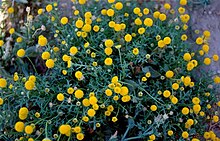Aaron Aaronsohn
Aaron Aaronsohn | |
|---|---|
Bacău, Romania | |
| Died | 15 May 1919 (aged 42) The English Channel |
| Relatives | (sister)
Alexander Aaronsohn (brother) |
| Known for | Discoverer of political activism |
| Author abbrev. (botany) | Aarons. |
Aaron Aaronsohn (
Biography

Aaron Aaronsohn was born in
Agriculture and botany
After studying agriculture in France, sponsored by Baron
He botanically mapped Palestine and its surroundings and became a leading expert on the subject. On his 1906 field trip to
This discovery made Aaronsohn world-famous and, on a trip to the United States, he was able to secure financial backing for a research station established in Atlit in 1909. Aaronsohn built up a large collection of geological and botanical samples and established a library.[10]
Aaronsohn served as a scientific consultant to Djemal Pasha during a crop-destroying desert locust invasion in 1915.[11] In March–October of that year, the locusts stripped the country of almost all vegetation.[12] Aaronsohn and the team fighting the locust invasion was given permission to move around the area known as Southern Syria (including modern day Israel) and made detailed maps of the areas they surveyed. Aaronsohn also collected strategic information about Ottoman camps and troop deployment.
In 1918, Aaronsohn was one of the experts consulted for the purpose of demarcating the northern boundary of Palestine, focusing on the need for irrigation water. He envisaged a boundary that would assure the inclusion of the sources of the Jordan, Litani and Yarmuk rivers. His approach became the official Zionist baseline presented to the Peace Conference in Paris in February 1919.[13]
Political activity and espionage
During World War I, the Ottomans had joined sides with the Germans, and Aaronsohn feared the Jews would suffer the same fate as the Armenians under the Turks. Together with his assistant
In 1917, Chaim Weizmann sent Aaronsohn on a political campaign to the USA. While there, Aaronsohn learned that the Ottoman authorities had intercepted a Nili carrier pigeon, which led to the arrest and torture of his sister Sarah and other members of the underground.[14]
Death and legacy
After the war, Weizmann called on Aaronsohn to work on the
Aaronsohn died a bachelor and had no children. His research on
After Aaronsohn's death, the director of British Military Intelligence confirmed that Allenby's victory would not have been possible without the information supplied by the Aaronsohn group.[17]
Published works
- Agricultural and botanical explorations in Palestine, 1910
- "Shemot ha-tzemachim" ("Botanical names"), in: Hashelaḥ 26 (1912)
- Reliquiae Aaronsohnianae, 1940
The standard author abbreviation Aarons. is used to indicate this person as the author when citing a botanical name.[18]
See also
References
- ^ a b Molecular Genetic Maps in Wild Emmer Wheat
- ^ Aaron Aharonson (1876-1919) Romanian Jewish agronomist, botanist, and Zionist activist
- ^ a b c d Spy, agronomist, entrepreneur: The Israeli Legacy of Aaron Aaronsohn, Haaretz
- ^ "Sarah Aaronsohn – Jewish Women's Archive". jwa.org. Retrieved 5 October 2017.
- ^ "Sarah Aaronsohn | Encyclopedia.com". www.encyclopedia.com. Retrieved 12 December 2020.
- ^ "NILI and the Issue of Divided Loyalties in the Jewish Yishuv of Ottoman Palestine" (PDF). Institute for Palestine Studies. Retrieved 18 September 2021.
- ^ Aaron Aaronsohn: Forgotten man of history? Cecil Bloom, Jewish Historical Studies
- ^ Valkoun, J., "The geographical distribution of wild wheats in their historical setting and current context" in The Linnean "Wheat Taxonomy: the legacy of John Percival", Special Issue 3, 2001. Page 82.
- ^ Palestine Exploration Fund (1908). Quarterly Statement - Palestine Exploration Fund. Palestine Exploration Fund.
- ^ Biography of Aaron Aaronsohn
- ^ a b Lawrence and Aaronsohn: T. E. Lawrence, Aaron Aaronsohn, and the Seeds of the Arab-Israeli Conflict, Ronald Florence Archived 22 December 2010 at the Wayback Machine
- ^ The Locust Plague
- ^ The Boundaries of Modern Palestine, 1840-1947, Gideon Biger
- ^ These pigeons flew for a Jewish Palestine
- ^ "Lawrence and Aaronsohn". Archived from the original on 9 October 2020. Retrieved 8 October 2020.
- ^ "The Aaronsohn Saga". Archived from the original on 3 March 2016. Retrieved 9 October 2012.
- ^ Aaronsohn: Encyclopedia.com
- ^ International Plant Names Index. Aarons.
Further reading
- Ronald Florence, Lawrence and Aaronsohn: T. E. Lawrence, Aaron Aaronsohn, and the Seeds of the Arab-Israeli Conflict, 2007, Viking Adult, ISBN 978-0-670-06351-2.
- Chaim Herzog, Heroes of Israel, 1989, Little Brown and Company, Boston ISBN 0-316-35901-7
- Goldstone, Patricia. Aaronsohn's Maps: The Untold Story of the Man Who Might Have Created Peace in the Middle East. San Diego: Harcourt, 2007.
- Shmuel Katz, The Aaronsohn Saga, 2007, Gefen Publishing House, Jerusalem ISBN 978-965-229-416-6
- Anderson, Scott. Lawerence in Arabia: War, Deceit, Imperial Folly and the Making of the Modern Middle East, 2013, Doubleday, ISBN 978-0-385-53292-1.
- ISBN 978-965-482-889-5
- Recent research on the genetic potential of the wild emmer discovered by Aaronsohn. Abstract of "Evolutionary agriculture domestication of wild emmer wheat" by Junhua Peng & Eviatar Nevo. Chapter 8 (pp. 193–255) of New Horizons in Evolution. Academic Press/Elsevier (2021), . Via sciencedirect.com. Accessed 2021-12-18.
External links
- Aaron Aharonson (1876-1919) Archived 25 May 2018 at the Wayback Machine on the Jewish Agency website


